- Home
- H. P. Lovecraft
Dream Cycle of H. P. Lovecraft: Dreams of Terror and Death
Dream Cycle of H. P. Lovecraft: Dreams of Terror and Death Read online
THE DREAM CYCLE OF H. P. LOVECRAFT
DREAMS OF TERROR AND DEATH
H. P. Lovecraft
A Del Rey® Book
Ballantine Books • New York
Contents
Title Page
INTRODUCTION: Concerning Dreams and Nightmares
Azathoth
The Descendant
The Thing in the Moonlight
Polaris
Beyond the Wall of Sleep
The Doom That Came to Sarnath
The Statement of Randolph Carter
The Cats of Ulthar
Celephais
From Beyond
Nyarlathotep
The Nameless City
The Other Gods
Ex Oblivione
The Quest of Iranon
The Hound
Hypnos
What the Moon Brings
Pickman’s Model
The Dream Quest of Unknown Kadath
The Silver Key
The Strange High House in the Mist
The Case of Charles Dexter Ward
The Dreams in the Witch-House
Through the Gates of the Silver Key
Endnotes
Books by H. P. Lovecraft
Quotes
Copyright Page
Concerning Dreams and Nightmares
If Literature is the world, then Fantasy and Horror are twin cities, divided by a river of black water. Horror is a rather more dangerous place, or it should be: you can walk around Fantasy alone.
And if Horror and Fantasy are cities, then H. P. Lovecraft is the kind of long street that runs from the outskirts of the first city to the end of the other. It began as a minor thoroughfare, and is now a six-lane highway, built up on every side.
That’s H. P. Lovecraft the phenomenon. H. P. Lovecraft the man died at the age of forty-seven, over fifty years ago…
The man: thin, ascetic, an anachronism in his own time.
There’s a World Fantasy Award on the stairs; I pat its head as I walk past. A Gahan Wilson sculpture of Howard Phillips Lovecraft (1890–1937), it’s a portrait of a thin-lipped man, with a high forehead, a long chin, and wide eyes. He looks vaguely uncomfortable, vaguely alien, an Easter Island statue of a man.
He was a solitary individual, an inhabitant of Providence, Rhode Island. He communicated with the outside world through letters, some of them the length of short novels.
He wrote for the pulps: disposable fiction for publications like Weird Tales, its covers often showing vaguely arty lesbian bondage scenes. He ghostwrote a Houdini story, rewrote the work of aspiring writers; he sold both— At the Mountains of Madness and The Shadows of Time— to F. Orlin Tremaine’s Astounding Stories.
He was a believer in unpleasant doctrines of racial superiority, and was an Anglophile. He was a student of horror. There is an abundance of conjectures as to the circumstances of his life and death, of the roots of his fiction, but they remain theories.
In his lifetime, he wasn’t a major writer. He wasn’t even a minor writer. He was a minor pulp writer, as forgettable as any of his time. (Quick! Can you name five other writers for Weird Tales in the twenties and thirties?) But there was something there which, like Lovecraft’s own Cthulhu, did not die.
(Poor Robert E. Howard, creator of Conan and of King Kull, is one of the other Weird Tales authors who’s still remembered, when Seabury Quinn and many of the rest of them have blown away into the footnotes. Howard killed himself at the age of thirty, in 1936, when he heard of his mother’s impending death. Then there’s Robert Bloch, who, at the age of 18, published his first professional short story in Weird Tales, and went on to a long and distinguished career.)
Some of the influence of Lovecraft was immediate. His correspondents and fellow writers, including Bloch, Fritz Leiber, Manly Wade Wellman, and others, played with the mythos he created: a world in which we exist in a tiny fragment of space-time, in which space, inner and outer, is vast, and is inhabited by things that mean us harm, and by other things to which we matter less than cosmic dust. Much of Lovecraft’s influence on fiction, however, would not really be felt until fifty years after his death.
His fiction was not collected while he lived. August Derleth, Wisconsin author, cofounded (with Donald Wandrei) the small press Arkham House, in order to publish Lovecraft’s fiction, and Derleth first collected Lovecraft’s prose in The Outsider and Others, two years after Lovecraft’s death. Since then Lovecraft’s stories have been collected and re-collected internationally, in many anthologies, in many permutations.
This anthology is about dreams.
Dreams are strange things, dangerous and odd.
Last night I dreamed I was on the run from the government, somewhere in middle Europe— the last holdout of a decayed communist regime. I was kidnapped by the secret police, thrown in the back of a van. I knew that the secret police were vampires, and that they were scared of cats (for all vampires were scared of cats, in my dream). And I remember escaping from the van at a traffic light, running through the city, trying to call several unresponsive city cats to me: grey and sleek and skittish, they were unaware that they could save my life…
It is possible to go mad, looking for symbolism in dreams, looking for one-to-one correspondences with life. But the cats are Lovecraft’s. And the vampiric secret police, in their own way, are his, too.
Lovecraft got better as he went on.
That’s a polite way of putting it.
He was pretty dreadful when he started out: he seemed to have no ear for the music of words, no real sense of what he was trying to do with stories. There’s no feeling in the earliest material of someone putting their life, or even the inside of their head, down on paper; instead, we watch Lovecraft in the beginning, copying, pastiching awkwardly— here’s a dash of Poe, there’s a little Robert W. Chambers— and over and above all the other voices of Lovecraft’s early days, the awkward Anglophilic imitation of the voice of Lord Dunsany, the Irish lord and fantasist, whom Lovecraft admired more, perhaps, than was good for his fiction.
Dunsany was one of the great originals. His prose voice resonated like an oriental retelling of the King James Bible. He told stories of strange little gods of faraway lands, of visits to dreamlands, of people with odd but perfectly apt names; always with a slight amused detachment. Many of the stories you’ll find in this anthology, like “Hypnos,” or “The Quest of Iranon,” are vaguely Dunsanyish in tone.
Somewhere in there, however, as time passes, Lovecraft’s voice begins to emerge. The writing becomes assured. The landscape slowly becomes the inside of Lovecraft’s head.
It was September 1983, at the New Imperial Hotel in Birmingham, in the English Midlands: I had come to Birmingham for the British Fantasy Convention, to interview Gene Wolfe and Robert Silverberg for English magazines.
It was my first convention of any kind. I went to as many panels as I could, although I remember only one panel. The panelists were, if memory serves, authors
Brian Lumley, Ramsey Campbell, the late Karl Edward Wagner, and Irish illustrator Dave Carson.
They talked about the influence of Lovecraft on each of them: Campbell’s hallucinatory tales of urban menace, Lumley’s muscular horror, Wagner’s dark sword and sorcery and modern, slick tales; they talked about the psychology of Lovecraft, the nightmarish visions, how each of them had found something in Lovecraft to which he responded, something that had inspired him: three very different authors, with three very different approaches.
A thin, elderly gentleman in the audience stood up and asked the panel whether they had given much thought to his own theory: that the Great Old Ones, the many-consonanted Lovecraftian beasties, had simply used poor Howard Phillips Lovecraft to talk to the world, to foster belief in themselves, prior to their ultimate return.
I don’t remember what the panel’s response was to that. I don’t recall them agreeing with it, though.
Then they were asked why they liked Lovecraft. They talked of the huge vistas of his imagination, of the way his fiction was a metaphor for everything we didn’t know and feared, from sex to foreigners. They talked about all that deep stuff.
Then Dave Carson, the artist, was handed the mike. “F——— all that,” he said happily, having drunk a great deal of alcohol, dismissing all the erudite psychological theories about Lovecraft and cutting to the chase. “I love H. P. Lovecraft because I just like drawing monsters.”
Which got a laugh from the audience, and a bigger laugh when Dave’s head gently touched down on the table a few seconds later, and then Karl Edward Wagner took the microphone from Dave’s fingers, and asked for the next question. (And now, a decade later, Dave Carson’s still with us, last heard of fishing off the pier at Eastbourne, probably fishing up the strange Lovecraftian beasties he draws so well from the depths of the English Channel so he can use them for reference, but the bottle carried away poor Karl.)
It’s true, though. Lovecraft’s influenced people as diverse as Stephen King and Colin Wilson, Umberto Eco and John Carpenter. He’s all over the cultural landscape: references to Lovecraft, and Lovecraftian ideas, abound in film, television, comics, role playing games, computer games, virtual reality…
Lovecraft is a resonating wave. He’s rock and roll.
I’m introducing a collection here that takes us though the dream fiction of H. P. Lovecraft, weaving it into a huge tapestry that drives from Fantasy to Horror and back again. Here’s the tale of “Pickman’s Model”— pure horror, and vintage Lovecraft— and then there’s Richard Upton Pickman, creeping through “The Dream Quest of Unknown Kadath”…The arrangement of stories forms odd patterns. Dreams and nightmares, too. Vampires and cats.
There’s something about Lovecraft’s fiction, about his worlds, that is oddly alluring for a writer of fantasy and horror. I’ve written three Lovecraftian stories: one obliquely, in Sandman—a quiet, dreamlike story (it’s the first story in the World’s End collection. You can tell it’s Lovecraftian, because I use the word “cyclopian” in it); one a hard-boiled Maltese Falcon variation with a werewolf as hero (in Stephen Jones’s fine anthology Shadows Over Innsmouth); and a third, when I was much younger, that was an awkward attempt at humor, an extract from Cthulhu’s autobiography. If I go back to Lovecraft again (and I’m sure I shall, before I die) it will probably be for something else entirely.
So what is it about Lovecraft that keeps me coming back? That keeps any of us coming back? I don’t know. Maybe it’s just that we like the way he gives us monsters to draw with our minds.
If this is your first excursion into H. P. Lovecraft’s world, you may find the way a little bumpy at first. But keep going.
You’ll soon find yourself driving down a road that will take you through the Twin Cities, and off into the darkness beyond.
If Literature’s the world.
And it is.
NEIL GAIMAN
APRIL 1995
Neil Gaiman is mentioned only once in the Lovecraft canon; the mysterious Dr. Charriere, in the Lovecraft-Derleth collaboration “The Survivor,” we are told, has a portrait of Gaiman on his wall, along with certain cabalistic charts, and pictures of large reptiles. Gaiman won the 1995 International Horror Critics’ Guild Award for best collection for his book Angels and Visitations, and has won pretty much every award, American and international, that it’s possible to get for writing comics, and one award that it’s impossible to get for writing comics any more, the aforementioned World Fantasy Award, for best short story (for Sandman #19)
THE DREAM CYCLE OF H. P. LOVECRAFT
DREAMS OF TERROR AND DEATH
THREE FRAGMENTS
These fragments found among Lovecraft’s papers are presumably his attempts to set down in rudimentary form, preparatory to expansion into longer stories, some of his dreams. None was ever expanded. Keys to the dream sources of some of these fragments can be found in Lovecraft’s letters.
Azathoth
When age fell upon the world, and wonder went out of the minds of men; when grey cities reared to smoky skies tall towers grim and ugly, in whose shadow none might dream of the sun or of Spring’s flowering meads; when learning stripped Earth of her mantle of beauty, and poets sang no more save of twisted phantoms seen with bleared and inward-looking eyes; when these things had come to pass, and childish hopes had gone away for ever, there was a man who traveled out of life on a quest into the spaces whither the world’s dreams had fled.
Of the name and abode of this man but little is written, for they were of the waking world only; yet it is said that both were obscure. It is enough to know that he dwelt in a city of high walls where sterile twilight reigned, and that he toiled all day among shadow and turmoil, coming home at evening to a room whose one window opened not on the fields and groves but on a dim court where other windows stared in dull despair. From that casement one might see only walls and windows, except sometimes when one leaned far out and peered aloft at the small stars that passed. And because mere walls and windows must soon drive to madness a man who dreams and reads much, the dweller in that room used night after night to lean out and peer aloft to glimpse some fragment of things beyond the waking world and the greyness of tall cities. After years he began to call the slow-sailing stars by name, and to follow them in fancy when they glided regretfully out of sight; till at length his vision opened to many secret vistas whose existence no common eye suspects. And one night a mighty gulf was bridged, and the dream-haunted skies swelled down to the lonely watcher’s window to merge with the close air of his room and make him a part of their fabulous wonder.
There came to that room wild streams of violet midnight glittering with dust of gold; vortices of dust and fire, swirling out of the ultimate spaces and heavy with perfumes from beyond the worlds. Opiate oceans poured there, litten by suns that the eye may never behold and having in their whirlpools strange dolphins and sea-nymphs of unrememberable deeps. Noiseless infinity eddied around the dreamer and wafted him away without even touching the body that leaned stiffly from the lonely window; and for days not counted in men’s calendars the tides of far spheres bore him gently to join the dreams for which he longed; the dreams that men have lost. And in the course of many cycles they tenderly left him sleeping on a green sunrise shore; a green shore fragrant with lotus-blossoms and starred by red camalates….
(circa 1922)
The Descendant
Writing on what the doctor tells me is my deathbed, my most hideous fear is that the man is wrong. I suppose I shall seem to be buried next week, but….
In London there is a man who screams when the church bells ring. He lives all alone with his streaked cat in Gray’s Inn, and people call him harmlessly mad. His room is filled with books of the tamest and most puerile kind, and hour after hour he tries to lose himself in their feeble p
ages. All he seeks from life is not to think. For some reason thought is very horrible to him, and anything which stirs the imagination he flees as a plague. He is very thin and grey and wrinkled, but there are those who declare he is not nearly so old as he looks. Fear has its grisly claws upon him, and a sound will make him start with staring eyes and sweat-beaded forehead. Friends and companions he shuns, for he wishes to answer no questions. Those who once knew him as scholar and aesthete say it is very pitiful to see him now. He dropped them all years ago, and no one feels sure whether he left the country or merely sank from sight in some hidden byway. It is a decade now since he moved into Gray’s Inn, and of where he had been he would say nothing till the night young Williams bought the Necronomicon.
Williams was a dreamer, and only twenty-three, and when he moved into the ancient house he felt a strangeness and a breath of cosmic wind about the grey wizened man in the next room. He forced his friendship where old friends dared not force theirs, and marvelled at the fright that sat upon this gaunt, haggard watcher and listener. For that the man always watched and listened no one could doubt. He watched and listened with his mind more than with his eyes and ears, and strove every moment to drown something in his ceaseless poring over gay, insipid novels. And when the church bells rang he would stop his ears and scream, and the grey cat that dwelt with him would howl in unison till the last peal died reverberantly away.
But try as Williams would, he could not make his neighbour speak of anything profound or hidden. The old man would not live up to his aspect and manner, but would feign a smile and a light tone and prattle feverishly and frantically of cheerful trifles; his voice every moment rising and thickening till at last it would split in a piping and incoherent falsetto. That his learning was deep and thorough, his most trivial remarks made abundantly clear; and Williams was not surprised to hear that he had been to Harrow and Oxford. Later it developed that he was none other than Lord Northam, of whose ancient hereditary castle on the Yorkshire coast so many odd things were told; but when Williams tried to talk of the castle, and of its reputed Roman origin, he refused to admit that there was anything unusual about it. He even tittered shrilly when the subject of the supposed undercrypts, hewn out of the solid crag that frowns on the North Sea, was brought up.

 The Best of H.P. Lovecraft
The Best of H.P. Lovecraft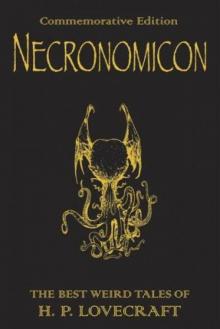 The Definitive H.P. Lovecraft: 67 Tales Of Horror In One Volume
The Definitive H.P. Lovecraft: 67 Tales Of Horror In One Volume The Complete Works of H.P. Lovecraft
The Complete Works of H.P. Lovecraft Other Gods and More Unearthly Tales
Other Gods and More Unearthly Tales Lovecraft's Fiction Volume I, 1905-1925
Lovecraft's Fiction Volume I, 1905-1925 The Shadow Out of Time
The Shadow Out of Time The Shunned House
The Shunned House Lovecraft's Fiction Volume II, 1926-1928
Lovecraft's Fiction Volume II, 1926-1928 The Thing on the Doorstep and Other Weird Stories
The Thing on the Doorstep and Other Weird Stories Dream Cycle of H. P. Lovecraft: Dreams of Terror and Death
Dream Cycle of H. P. Lovecraft: Dreams of Terror and Death Great Tales of Horror
Great Tales of Horror Shadows of Death
Shadows of Death Delphi Complete Works of H. P. Lovecraft (Illustrated)
Delphi Complete Works of H. P. Lovecraft (Illustrated) Waking Up Screaming: Haunting Tales of Terror
Waking Up Screaming: Haunting Tales of Terror H.P. Lovecraft Goes to the Movies
H.P. Lovecraft Goes to the Movies The Road to Madness
The Road to Madness The Complete H.P. Lovecraft Reader (68 Stories)
The Complete H.P. Lovecraft Reader (68 Stories) The Horror in the Museum
The Horror in the Museum Collected Fiction Volume 1 (1905-1925): A Variorum Edition
Collected Fiction Volume 1 (1905-1925): A Variorum Edition Lovecrafts_Fiction, vol.I_1905-1925
Lovecrafts_Fiction, vol.I_1905-1925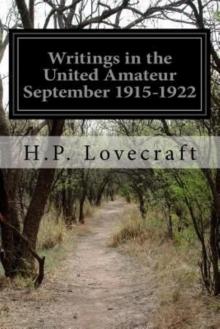 Writings in the United Amateur, 1915-1922
Writings in the United Amateur, 1915-1922 H.P. Lovecraft: The Complete Works
H.P. Lovecraft: The Complete Works Collected Fiction Volume 3 (1931-1936): A Variorum Edition
Collected Fiction Volume 3 (1931-1936): A Variorum Edition H.P. Lovecraft: The Complete Fiction
H.P. Lovecraft: The Complete Fiction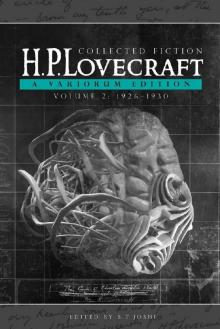 Collected Fiction Volume 2 (1926-1930): A Variorum Edition
Collected Fiction Volume 2 (1926-1930): A Variorum Edition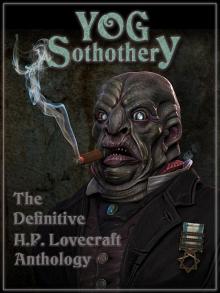 Yog Sothothery - The Definitive H.P. Lovecraft Anthology
Yog Sothothery - The Definitive H.P. Lovecraft Anthology The Complete H.P. Lovecraft Collection (Xist Classics)
The Complete H.P. Lovecraft Collection (Xist Classics)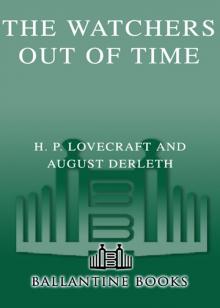 The Watchers Out of Time
The Watchers Out of Time Eldritch Tales
Eldritch Tales The Other Gods And More Unearthly Tales
The Other Gods And More Unearthly Tales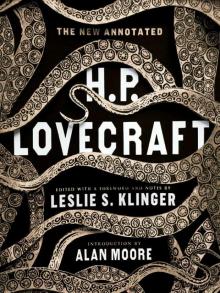 The New Annotated H. P. Lovecraft
The New Annotated H. P. Lovecraft At the mountains of madness
At the mountains of madness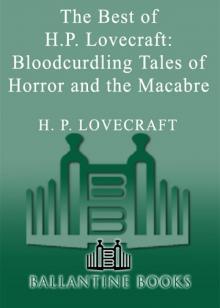 Bloodcurdling Tales of Horror and the Macabre
Bloodcurdling Tales of Horror and the Macabre Fossil Lake II: The Refossiling
Fossil Lake II: The Refossiling Shadows of Carcosa: Tales of Cosmic Horror by Lovecraft, Chambers, Machen, Poe, and Other Masters of the Weird
Shadows of Carcosa: Tales of Cosmic Horror by Lovecraft, Chambers, Machen, Poe, and Other Masters of the Weird H. P. Lovecraft
H. P. Lovecraft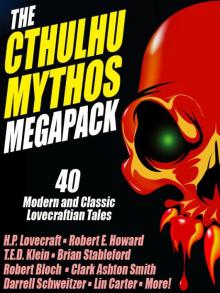 The Cthulhu Mythos Megapack
The Cthulhu Mythos Megapack The Complete H. P. Lovecraft Reader (2nd Edition)
The Complete H. P. Lovecraft Reader (2nd Edition) The Complete Fiction
The Complete Fiction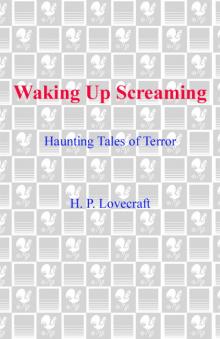 Waking Up Screaming
Waking Up Screaming Transition of H. P. Lovecraft
Transition of H. P. Lovecraft![[1935] The Shadow Out of Time Read online](http://i1.bookreadfree.com/i2/04/12/1935_the_shadow_out_of_time_preview.jpg) [1935] The Shadow Out of Time
[1935] The Shadow Out of Time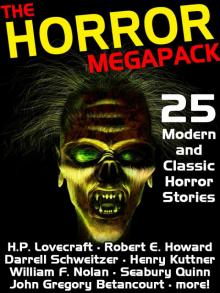 The Horror Megapack
The Horror Megapack